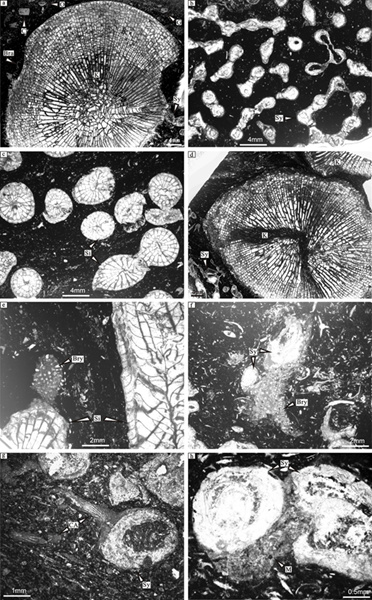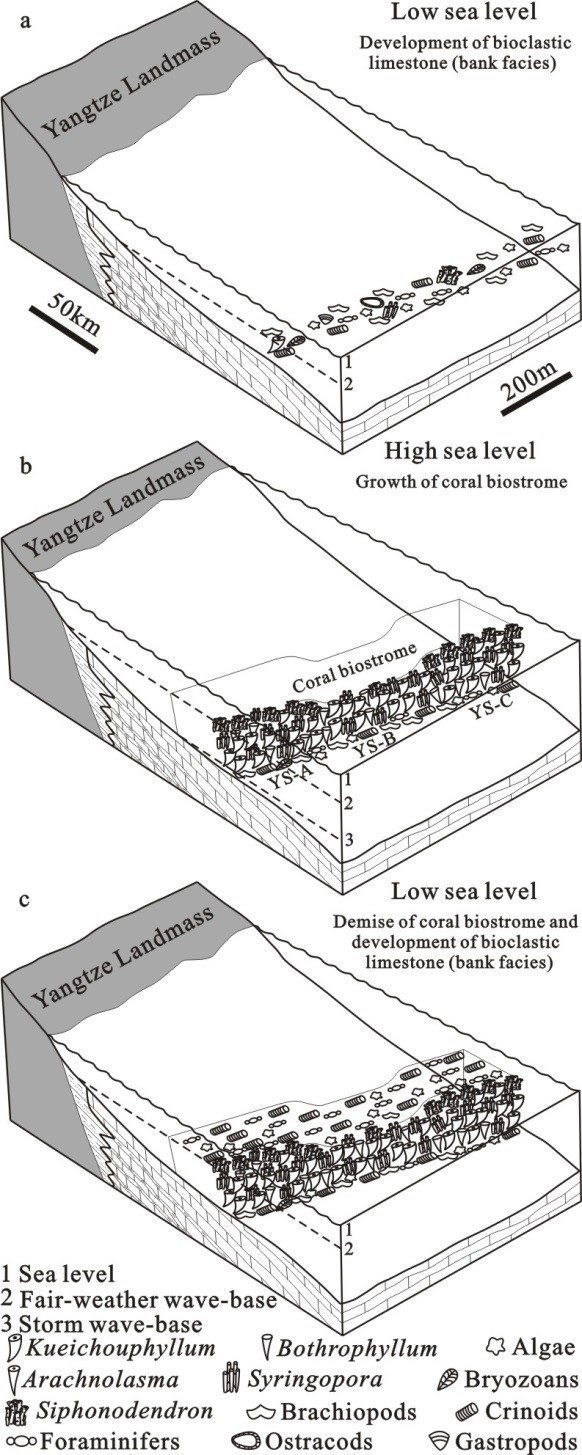
Microfacies types of the coral biostrome. (a) Kueichouphyllum bafflestone. (b-d) Syringopora, Siphonodendron and Kueichouphyllum-Syringopora bafflestone and framestone. (e-h) Coral, bryozoan, calcareous algae and microbial floatstone.
The Mississippian was an important interval for reef evolution when metazoan bioconstructions recovered after the collapse of coral-stromatoporoid reefal ecosystem during the Late Devonian mass extinction event. In the Tournaisian times, no metazoan bioconstructions have been reported, which did not appear until the early Viséan and then gradually flourished. The diversity and abundance of metazoan bioconstructions reached maximum value during the late Viséan. As a type of metazoan bioconstruction, coral biostromes also recovered and flourished during the Viséan. They occurred first in the middle Viséan and gradually increased to peak value during the late Viséan, which were widely distributed in Western Europe and North Africa (western Palaeotethys). To date, no Viséan coral biostromes have been reported in South China (eastern Palaeotethys). Their compositions and relationships to coeval coral biostromes in western Palaeotethys are not understood.
To better understand the composition and evolution of the coral biostromes during this critical interval in South China, a middle Viséan (Mississippian) coral biostrome from the Shangsi Formation in Yashui area, central Guizhou Province, southwestern China was detailly reported for the first time by Dr. YAO Le from Nanjing Institute of Geology and Palaeontology, Chinese Academy of Sciences. The biostrome is about 500 m across and 2.5~3.9 m thick, with low taxonomic diversity comprising 5 coral species belonging to 5 genera. The main builders are Siphonodendron pentalaxoidea, Syringopora sp. and Kueichouphyllum sinense. Associated fossils include abundant brachiopods, crinoids and common foraminifers together with rare calcareous algae, bryozoans, gastropods and ostracods. The lithological and microfacies types of the biostrome are abundant, mainly containing coral bafflestone and framestone, and bioclastic wackestone. Three growth stages of the biostrome are distinguished, based on different compositions of coral taxa, which are K. sinense growth stage, K. sinense-Syringopora sp. growth stage and S. pentalaxoidea growth stage in ascending order. Relative sea-level changes are interpreted to have controlled growth and demise of the biostrome. This coral biostrome has similar biotic composition to middle to late Viséan coral biostromes in Europe and North Africa. The approximately coeval occurrence of coral biostromes in both eastern and western Palaeotethys suggests that a relatively global warm episode existed during the Viséan Stage.

Model for sea-level changes controlling the growth and demise of the coral biostrome
The paper was published in Palaeogeography, Palaeoclimatology, Palaeoecology, and financially supported by the National Natural Science Foundation of China and the Ministry of Science and Technology Foundation Project.
Reference: Yao, L., Wang, X.D., Lin, W., Li, Y., Kershaw, S., Qie, W.K., 2016. Middle Viséan (Mississippian) coral biostrome in central Guizhou, southwestern China and its palaeoclimatological implications.Palaeogeography, Palaeoclimatology, Palaeoecology, 448: 179-194.
(Information Source: Nanjing Institute of Geology and Palaeontology, CAS)

